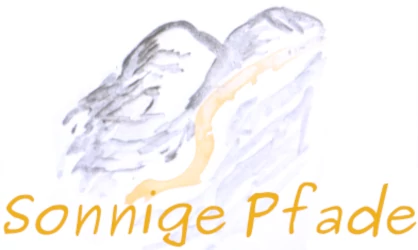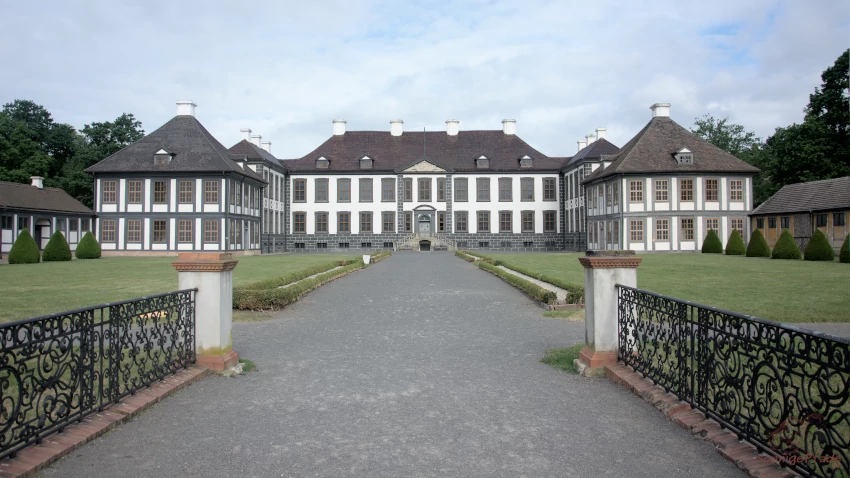
A visit to the Dessau – Worlitz Garden realm includes not only a walk in Worlitz Gardens, but also in Oranienbaum Palace and Park. Although the grounds are smaller, they offer an impression of Dutch Baroque and English gardens along the Elbe river. Until today there are connections from Oranienbaum to the Dutch royal house. Your discovery tour in the city and park of Oranienbaum ennobles your trip to the World Heritage Site Dessau Worlitz Garden realm.

The baroque transformation of Oranienbaum
Somewhat run down in the socialist era of the GDR (former east germany), Oranienbaum was for the many visitors to the Worlitz Gardens only a place of transit just before the destination on their journey. But this is completely unjustified – the castle, park and town of Oranienbaum are a special ensemble of the Baroque period and, in terms of their origin, are even older than the Worlitz Gardens. For Oranienbaum was built as early as 1645 on the property of Princess Agnes of Anhalt – Dessau as a „permanent home“, i.e. a small palace.
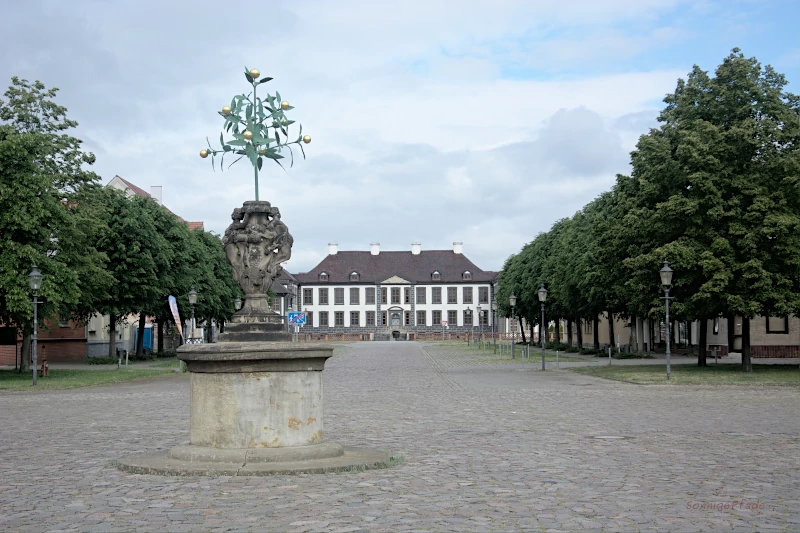
Long history and targeted economic development
As early as 1179 there was a settlement called Nischwitz in the area of Oranienbaum owned by the monastery of Nienburg, but it was abandoned around 1500. It was not until the initiative of Princess Agnes of Anhalt – Dessau that the deserted area was settled again from 1645.
The development of Oranienbaum really started around 1660 with the transfer of property to Princess Henriette Catharina von Oranien – Nassau, the wife of the then Prince Johann Georg II von Anhalt-Dessau. The lady of Dutch blood had business acumen and in 1669 suggested the construction of a glassworks. Breweries were added in 1693. Because of her descent from the House of Orange-Nassau, the princess gave the town the name Oranienbaum (orange tree) in 1673. Her three sisters married into German lands founded similarly named castles – Oranienburg, Oranienstein and Oranienhof.
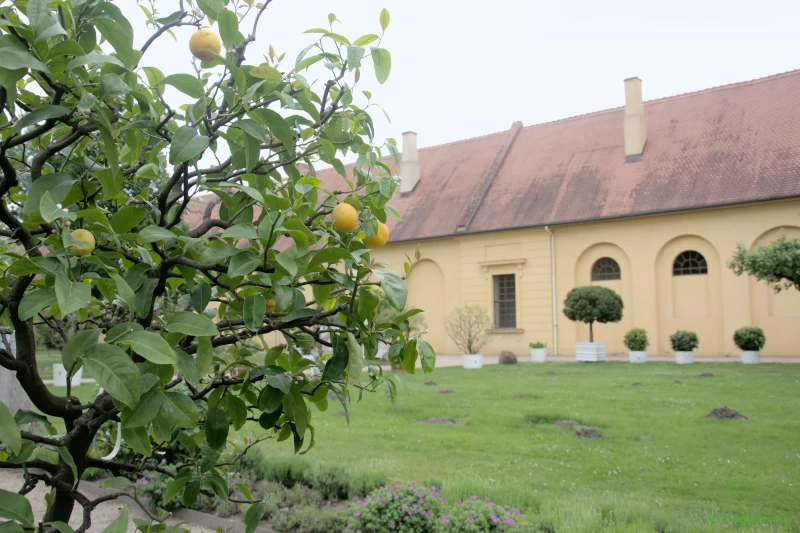
A town in the Dutch Baroque style emerges
From 1681 to 1685, the first phase of the chateau development in Oranienbaum was completed with a palace, cavalier pavilion and Baroque garden. For the time being, the palace served as a summer residence for the princess. At the same time Oranienbaum was built as a baroque town in geometrical forms, which took up the main axis of the palace and garden. The Dutch master builder Cornelis Ryckwaert was responsible for this.
Basic geometrical forms of the Baroque ensemble of the palace, garden and town are still preserved and clearly visible today. The market is located vis-à-vis the palace on a visual axis. The focal point of the market square is a wrought-iron orange tree with golden fruit. At right angles to it there is a second visual axis, at the southern end of which the baroque town church was built in 1712.
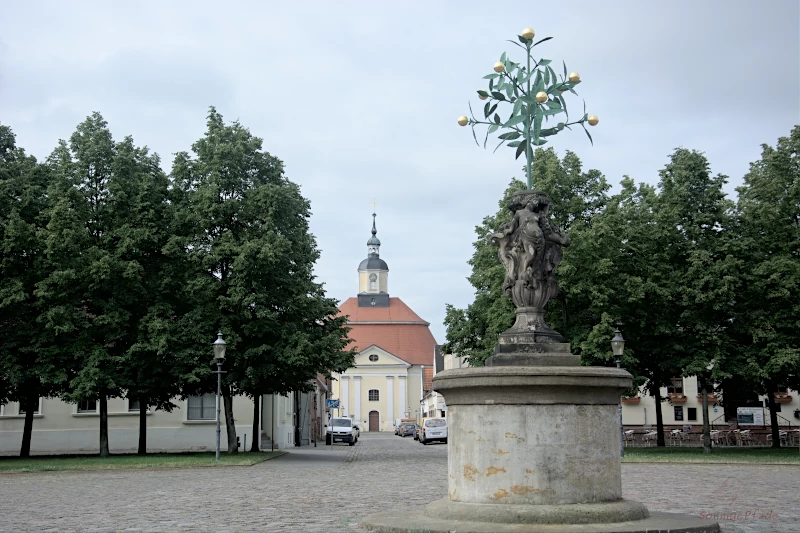
From 1693 onwards, various breweries were established in the town. Oranienbaum was granted market rights in 1695.
After the princess’s husband, Johann Georg II of Anhalt-Dessau, died in 1693, Oranienbaum Palace became the widow’s residence of Henriette Catharina. In this context, the palace was extended to a three-winged building, as it can be seen today. However, only parts of the rich interior decoration have been preserved. Famous is the leather wallpaper hall, which was covered with thin animal skins in accordance with the spirit of the time. This type of wall design was brought to Spain by the Moors and subsequently spread across Europe. In the Netherlands, the goudleer (gold leather) entered the noble houses during the Baroque period. Also preserved is the tile cellar, decorated with ceramic tiles from Delft in the Netherlands. Paintings and faiences (ceramics) remained only partially in the Oranienbaum castle. Parts of the painting collection can be seen in Mosigkau Palace, which also belongs to the Dessau – Worlitz Garden Realm.
Period of rest after the death of the princess
The princess died in 1708 and thus Oranienbaum Palace entered a period of dormancy. The palace was only occasionally used as a hunting lodge by the following princes. In 1712 Oranienbaum received the already mentioned baroque town church south of the market place. Otherwise, it is almost only worth mentioning that the princely Broyhans brewery was moved from Dessau to Oranienbaum.
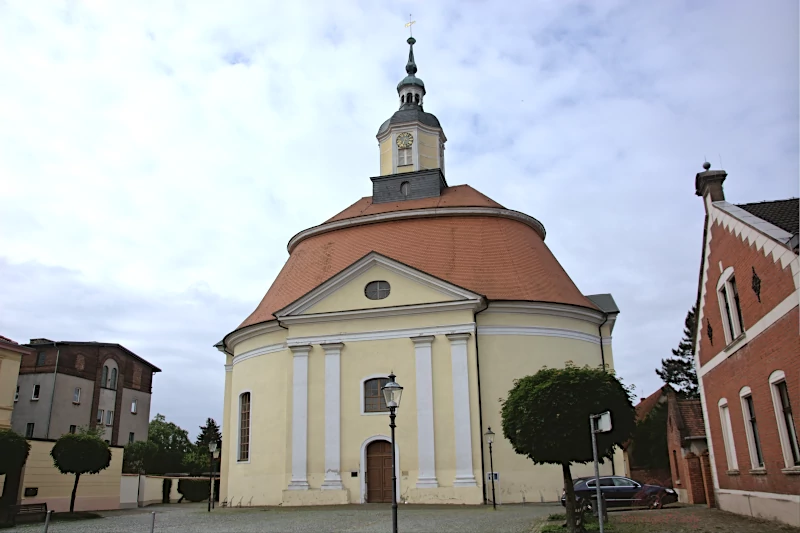
Oranienbaum as part of the Dessau Garden Realm
It was not until the great-grandson of the Princess of Orange-Nassau, Leopold Franz of Anhalt Dessau, that Oranienbaum Chateau came back to life. In the course of the comprehensive transformation of the whole Principality into the Garden Realm of Dessau – Worlitz, the Palace and Park of Oranienbaum were also reworked. In the palace, some rooms were furnished with Chinese elements. And in the park, a Chinese island garden with a teahouse, pagoda and arched bridges was laid out from 1793 to 97. It was modeled on the ideas of the English master gardener Sir William Chambers. The Chinese garden in the park of Oranienbaum is the only still preserved English – Chinese garden in Germany.
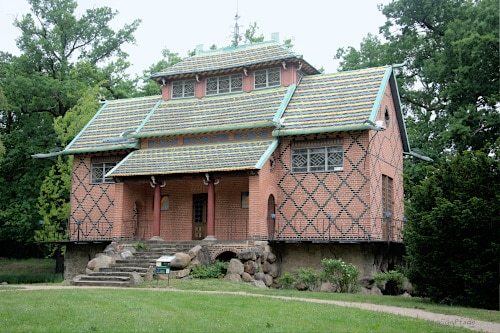
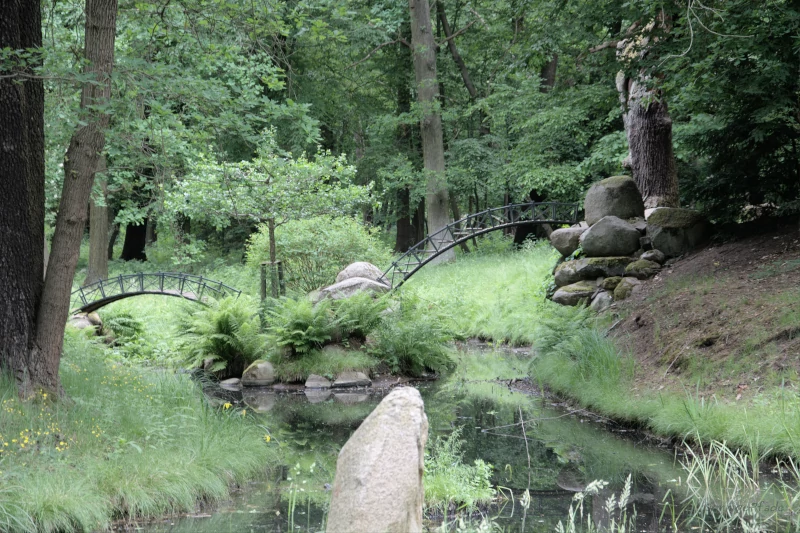
The Orangery
Starting in 1812, the Orangery was built on the southern edge of the park. The aim was to house the large collection of orange and citrus plants as well as other rare woody plants in a winter-proof building. Until today the 175m long orangery is used for this purpose. It is therefore a kind of historical greenhouse with large glass fronts facing south. These glass windows can be closed with high wooden shutters. In summer, the plants stand in large tubs outside, partly on the open space behind the orangery or also in the baroque garden behind the castle.
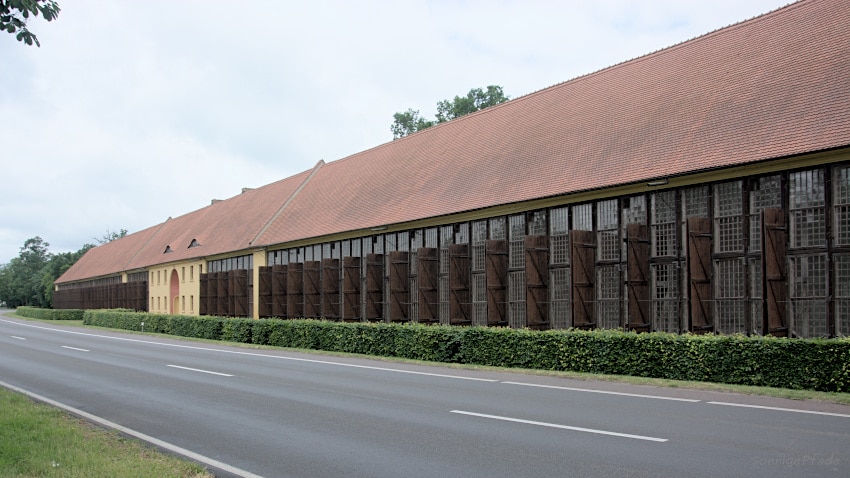
There is also a secluded gardener’s courtyard and a mysterious wooden tower to be discovered. I could still explain the vehicle underneath – a kind of forklift for gardeners. Plant pots can be hooked into the fork and then transported. The „plant tower“ remained a mystery to me at first. Until I realized at some point that the large, heavy orange trees also need to be „repotted“ from time to time. So if you drive the bucket with an orange tree under the planting tower, you can pull the orange up by the trunk with straps on a pulley and replace the pot underneath.
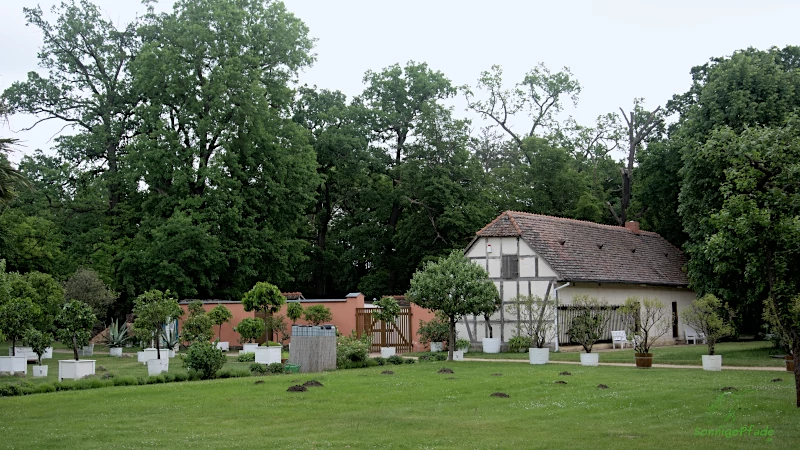
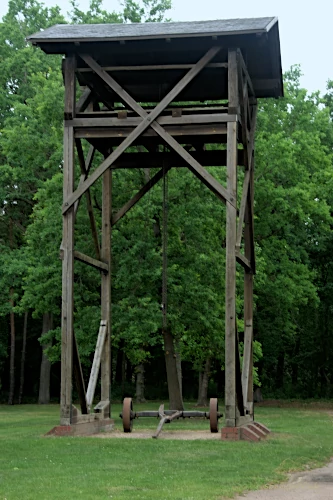
Sightseeing in Oranienbaum
Visit the Palace
While Worlitz Gardens is always well visited, Oranienbaum Palace and Park still leads a somewhat shadowy existence. Meanwhile, Oranienbaum has even had royal visitors: the former Dutch queen Beatrix is patron of the renovation in the chateau of her relatives and has already visited the town twice (2004 and 2012).

A stroll through the town of Oranienbaum is of course possible at any time. The park is open to all without admission – from May 21 from 7 am to 9 pm and from October 21 from 7 am to 6 pm.
Oranienbaum Palace can be visited inside only during opening hours as part of guided tours. Open in the season from 1 May to 30 September each Tuesday to Sunday (+holidays) 10 – 17 clock. From the middle of March, April, October and November the opening days are limited to weekends (+holidays). The visit to the Palace costs admission (full price currently 8.50 €), which can be combined with the Manor and Gothic House in Wörlitz and Mosigkau Manor by a 3-Palace- Card. Guided tours are offered.
Enjoy the park Oranienbaum
From my point of view, the park is divided into four parts. Directly behind the Palace is a baroque garden with a cross of paths, in the center of which is a fountain. Along the paths, as already described, are numerous exotic plants and citrus trees in tubs.
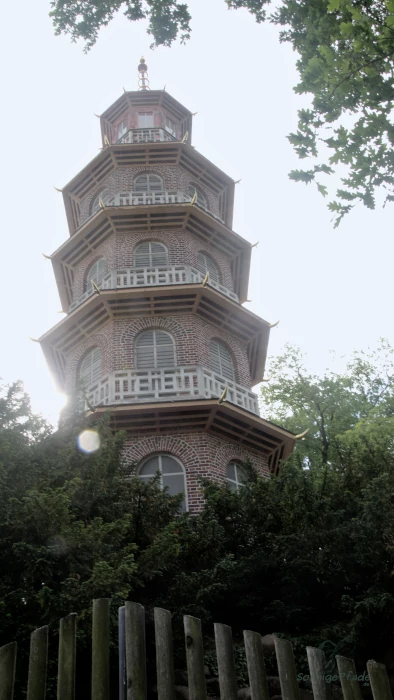
North of this garden you will find the Chinese Island Garden from the time of Prince Leopold Franz. This is a bit more primitive, even though it is a purposefully designed garden. The centerpiece is the Chinese Tea House on an island between artificial watercourses. It stands on a brick arch over one of the watercourses. Numerous bridges in various shapes create the connections from island to island. East of the teahouse you will find the tower of the five-story pagoda.
South of the baroque garden, unfortunately directly on the B 107 main street, the orangery stretches towards the sun. Between the orangery and the baroque garden is the square with the plant tower and the gardener’s yard. In one of the buildings at the gardener’s yard there is a new visitor’s toilet.
And then there is the western part of the park, which actually already has the character of a deciduous forest with tall, partly quite old trees. There the nature lovers get their money’s worth.
Access to the park is possible during opening hours through various gates – next to the orangery, at the castle, near the tea house… Cycling is not allowed in the park, bikes should be parked outside.
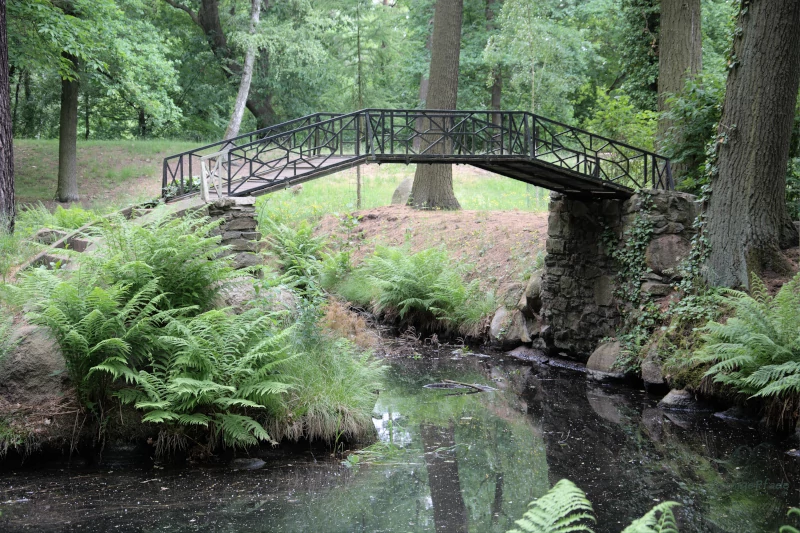
The Tobacco Collegium in the Oranienbaum Palace
For a long time the area around Oranienbaum was also a center of tobacco cultivation in Anhalt. From 1824 to 1968 tobacco was processed industrially in Oranienbaum. The Tobacco Collegium in the Northern Cavalier Pavilion, which is part of the exhibitions in Oranienbaum Palace, tells of this.
What else is there in Oranienbaum?
Opposite the Palace you will find a traditional restaurant – the Gasthaus zum Goldenen Hirsch (Inn to the Golden dear). Near the pagoda, outside the park, stands the Octagon – an octagonal brick building. So from the form already more interesting than „four walls, four corners“. But – today it is simply a residential building. The octagon was built as a Lutheran parish church in 1752 (the city church with there baroque building is a reformed one), after World War I it was deconsecrated and in 1920 it was converted into a residential building.
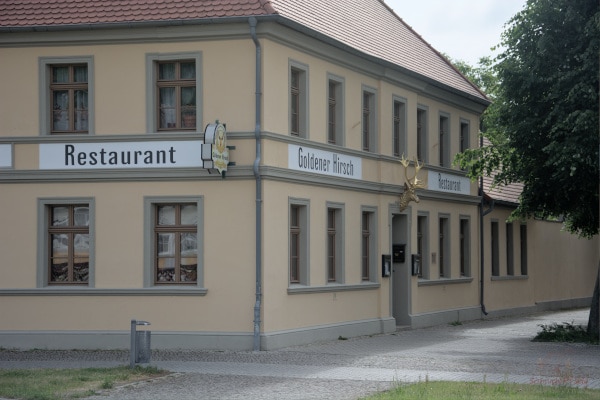
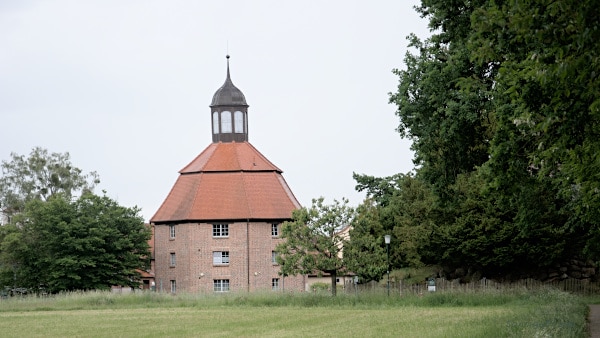
There is a „monument trail“ in Oranienbaum with 29 stations after all. Among them are also some old houses in the city – an Landcitizen house diagonally opposite the castle, a historic blacksmith’s shop at the market, etc. Sometimes it is written that houses in Oranienbaum are characterized by the „Dutch style“. However, I could not discover anything of it. Either my ideas of „Dutch style“ do not correspond to what is meant by it or the houses are too strongly „building market-technically overbuilt“ or they simply do not exist… whoever finds out something different about it, is welcome to comment below!
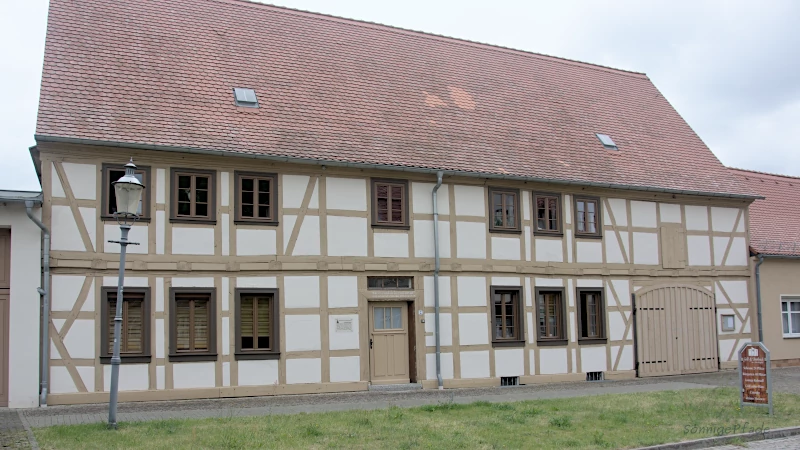
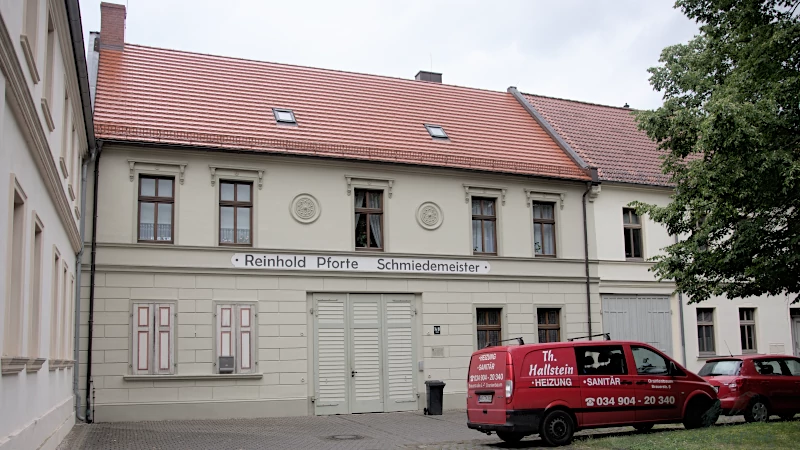
Travel tips for Oranienbaum
Of course you can see Oranienbaum and Worlitz Gardens „together“ – they are only 8km apart. But in my opinion one day is not enough for that. If you are really curious, you will find enough exciting stuff for one day in Oranienbaum alone. And Wörlitz, in view of its size, is always good for more time and attention.
The weather
How it looks today in Oranienbaum and whether an extended visit to the park is suitable, reveals you the adjacent weather – overview.
The journey
Next airport to the cultural heritage Dessau Worlitz Garden realm is the Leipzig – Halle airport (LEJ). There you can get full service with train station and car rental service.
You can easily get to Oranienbaum by public transport. The nearest train station* is Dessau main station. In the summer season, the Worlitz Railway runs from platform 1 with railcars and also makes a stop in Oraninenbaum. The Worlitz Railway is operated by Stadtwerke (City service) Dessau, DB tickets or mdv tickets are not valid. Bicycles can be taken on the Wörlitz Railway free of charge. Total distance to Wörlitz is 19km, a one-way ticket for adults costs 6.50€, there are „small“ and „large“ family tickets.
In addition, a plusBus – line 310 Gräfenhainichen – Oranienbaum – Dessau, which also operates on weekends and holidays. This would make the Gräfenhainichen train station (local trains only) another transfer option when arriving by train.

By car or rental car* you leave the A9 freeway between Leipzig and the Potsdam interchange at the Dessau Ost junction. Then you drive on the B 107 but not to Dessau, but in an easterly direction and already after about 8 km kilometers in Oranienbaum.
Parking in Oranienbaum is not a problem so far – there are many free parking spaces without fees in the area of the Orangerie or in the city area. With the camper* you should change to the campervan site at Worlitz Gardens (about 8km).
You can also arrive by bike. (So I was ultimately on the road …) Wörlitz is on the Elbe river cycle way between Wittenberg and Magdeburg. From Wörlitz to Oranienbaum it is only about 8km on a marked connecting path (sign with penny-farthing), which largely leads on dike or agricultural roads and only briefly on the normal road. Unfortunately, I have not found any lockable bicycle parking boxes in Oranienbaum, as they are now found at Worlitz Gardens. So with luggage you have to come up with something to secure it. When staying overnight in Oranienbaum, the accommodations usually offer secure bicycle parking.
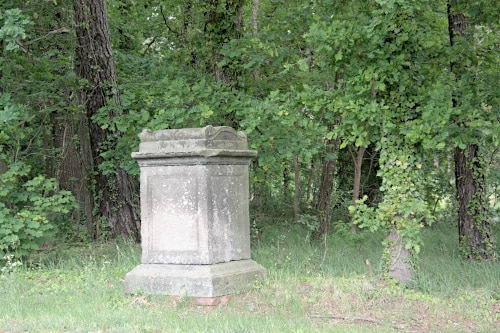
Accommodation in Oranienbaum – hotel and vacation apartment
Practically opposite the Orangerie stands the ***Hotel and Restaurant Goldener Fasan* and offers single and double rooms. A super starting point for exploring the whole World Heritage – Garden Realm Dessau – Wörlitz, because the hotel also holds rental bikes for its guests. So you can use the bike path and also visit the Worlitz Gardens park including the castle. If you travel, for example, on the Elbe Cycle Path with your own bicycles, you can have the bikes safely locked up at the Hotel Goldener Fasan – up to 25 bikes can be secured in this way. The hotel has a terrace and individual rooms with balconies. For children, there are board games as well as outdoor playground equipment. Extended excursions can be secured with packed lunches. Parking is available free of charge. Pets are allowed but chargeable.
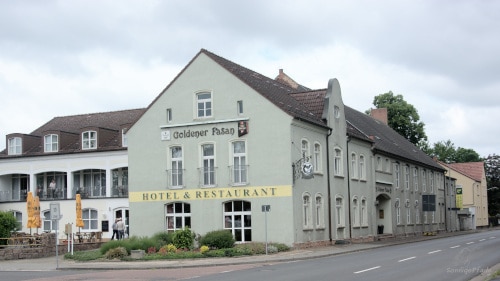
A vacation apartment over two floors for max. 6 persons is offered by the artists‘ quarter Ampelhaus* in Oranienbaum. This is an artists‘ house with exhibitions and studios, which now also receives guests. A kitchen is also available, so that even self-caterers will find everything they need. For evening entertainment there are board games. Those who like can meet with the hosts in the evening at the fire bowl in the courtyard. The castle and the park are only a few steps away on foot. There is a charging station for electric cars.
The Hotel Landhaus Wörlitzer Hof* is also popular with those who want to visit both Oranienbaum and Wörlitz. This hotel is located directly next to one of the park entrances, close to the Elbe river cycle way and only about 200m from Wörlitz Castle. Offered are spacious single and double rooms in different price categories, some also with suitable equipment for guests with limited mobility and wheelchair users. Bicycle travelers can safely park their bicycles in a locked room.
Further accommodation can be found in nearby Wörlitz and the surrounding area.
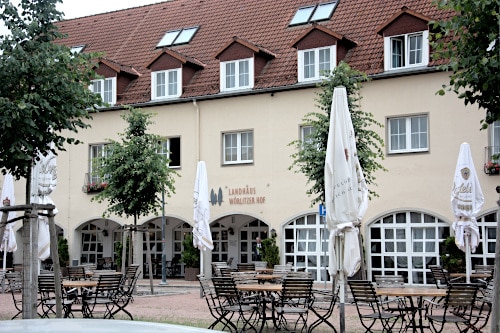
Fancy more garden realm?
Then visit the Worlitz Gardens, only 8 km north of Oranienbaum! … or one click away 😉 …
Already on your way to Oranienbaum? Invite your friends!
If you liked the post, share the link to the post on your social media channels and recruit your friends for the trip to Oranienbaum. Thank you!
Note on * advertising links
Some of the links are marked with *. These are advertising links that lead to a provider, hotel, store, etc.. If you click on the link and book something there, the sonnige pfade blog receives a small commission as a contribution to the operating costs. Nothing will be more expensive for you, because the provider already takes the commission into account in the pricing.
